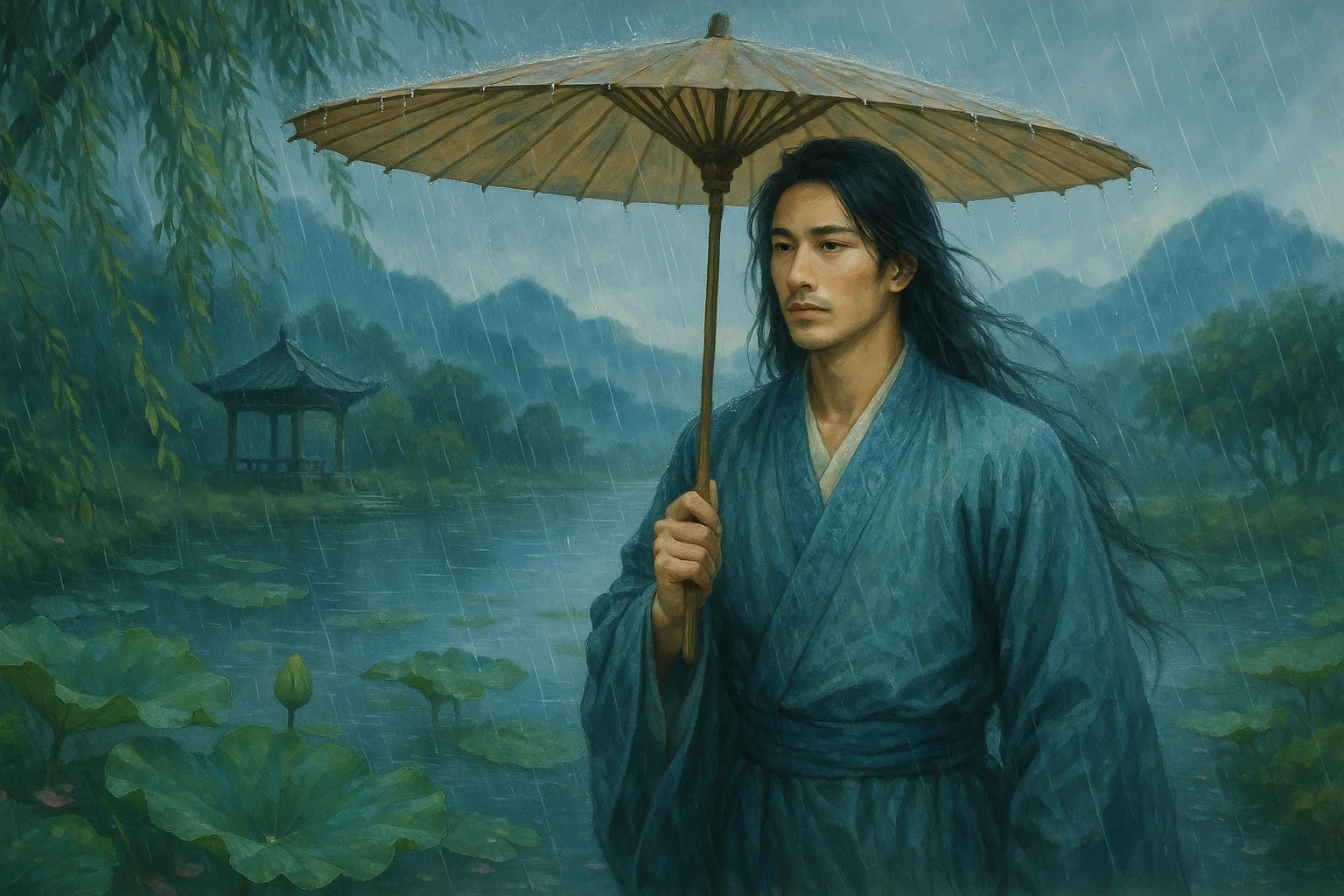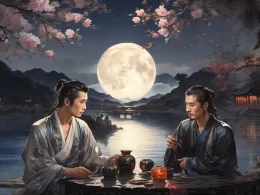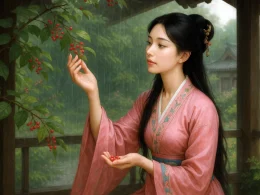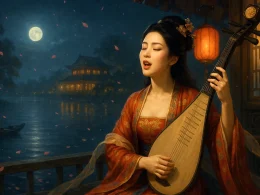In vain I bid the children sweep the snow away,
Through broken fences now I watch for spring’s relay.
Cold streams and hills lie drowned in mud so deep,
While old friends drift—I drink alone and weep.
Just straw sandals to tread on ice I own,
A cane to seek wild mumes by paths unknown.
Though aging like Jade Stream, I still survive,
Kind monks sometimes bring rice to keep alive.
Original Poem
「探春」
吕本中
谩遣儿童扫雪开,却穿篱落看春回。
溪山冷落泥三尺,故旧飘零酒一杯。
止买芒鞋供踏雪,更携藜杖与寻梅。
玉川纵老生涯在,时有邻僧送米来。
Interpretation
This poem, composed in early spring during Lü Benzhong’s later years, reflects a life tempered by political upheavals and personal losses. Having weathered the storms of officialdom, Lü now embraces simplicity, finding solace in nature’s quiet transitions. Though winter’s grip lingers—snow still blankets the ground—the poet’s eager anticipation of spring mirrors his undimmed spirit. The verses weave together joy at nature’s renewal, nostalgia for scattered friends, and contentment in humble, neighborly bonds, offering a portrait of old age marked by resilience and quiet grace.
First Couplet: "谩遣儿童扫雪开,却穿篱落看春回。"
Màn qiǎn értóng sǎo xuě kāi, què chuān lí luò kàn chūn huí.
Casually, I bid the children sweep aside the snow—
then slip through the hedge to spy on spring’s return.
The opening lines juxtapose domestic order and restless curiosity. "Casually" (谩) suggests an offhandedness that belies the poet’s urgency, while "slip through the hedge" (穿篱落) reveals his impatience—he cannot wait for spring to come to him. The children’s chore contrasts with the poet’s childlike pursuit, highlighting a mind unburdened by age.
Second Couplet: "溪山冷落泥三尺,故旧飘零酒一杯。"
Xī shān lěngluò ní sān chǐ, gùjiù piāolíng jiǔ yī bēi.
Streams and hills lie desolate under three feet of mud;
old friends scatter like leaves—I toast them alone.
Here, the mood darkens. "Three feet of mud" (泥三尺), a visceral image of thawing snow, embodies the slowness of seasonal change and the weight of solitude. "Old friends scatter like leaves" (故旧飘零) evokes the transience of human connections, while the solitary toast underscores the poet’s isolation. The couplet bridges external and internal landscapes—melting snow mirrors melting memories.
Third Couplet: "止买芒鞋供踏雪,更携藜杖与寻梅。"
Zhǐ mǎi máng xié gōng tà xuě, gèng xié lí zhàng yǔ xún méi.
I bought straw sandals just to tread the snow,
took up a cane to hunt for plum blossoms.
Defying the lingering chill, Lü prepares for active engagement with nature. "Straw sandals" (芒鞋) and "cane" (藜杖) are tools of a wanderer, signaling his readiness to seek beauty despite physical frailty. "Hunt for plum blossoms" (寻梅) elevates the act beyond mere stroll—it is a deliberate quest for resilience, as plums bloom defiantly in late winter.
Fourth Couplet: "玉川纵老生涯在,时有邻僧送米来。"
Yùchuān zòng lǎo shēngyá zài, shí yǒu lín sēng sòng mǐ lái.
Though aged like Lu Tong of Jade River,
my life persists—neighbor monks still bring rice.
The closing couplet anchors the poem in quiet triumph. Lü compares himself to Lu Tong (玉川子), a Tang poet-recluse, embracing a similarly unpretentious existence. The "neighbor monks" (邻僧) symbolize community and spiritual kinship, their rice offerings a testament to mutual care. Amidst desolation and decay, these small acts of kindness sustain the poet’s world.
Holistic Appreciation
This poem traces the rhythm of seasonal change, weaving together the joy of spring's return, reflections on life's flux, and the quiet pleasures of a contented existence. The opening couplet bursts with eager anticipation for spring; the second shifts to melancholy, merging scenery with human affairs; the third rekindles warmth through the image of "treading snow to seek plum blossoms"; the finale settles into tranquil intimacy, closing with humble acts of kindness that linger in the mind. Dynamic and static elements interweave, scenes fuse with emotions—vivid depictions of nature subtly hint at life’s philosophies. Lü Benzhong renders sincere feelings with plain strokes, crafting a poem that reads with natural simplicity yet resonates with profound depth.
Artistic Features
The poem’s brilliance lies in its seamless emotional flow. It moves from hopeful anticipation to wistful reflection, then to renewed passion, finally resolving in gentle warmth—a complete emotional arc. Its language is unadorned yet vivid: words like "vainly" (谩), "yet" (却), and "three feet of mud" (泥三尺) are precise and layered, conveying both immediacy and hidden meaning. The poet excels at using life’s small details to mirror inner states, blending literary grace with authentic lived experience.
Insights
This work teaches that life’s seasons mirror nature’s cycles: even amid winter’s chill and life’s mire, a heart attuned to spring can find beauty in the everyday. When snow lingers and old friends scatter, we may still nurture passion and poise—finding solace in small kindnesses and harmonious bonds. With humble brushstrokes, the poet paints a life philosophy: facing time’s flow and fortune’s turns, we need not chase perpetual splendor. Cherish the present, and spring will dwell eternally in the heart.
About the Poet

Lü Benzhong (吕本中 1084 - 1145), a native of Shouxian in Anhui, was a renowned poet and Neo-Confucian scholar of the Southern Song Dynasty. As a key theorist of the Jiangxi Poetry School, he proposed the concept of "living method" (huofa), advocating for natural variation within established poetic rules. With over 1,270 surviving poems, his Genealogy of the Jiangxi Poetry School (Jiangxi Shishe Zongpai Tu) established Huang Tingjian as the school's patriarch, profoundly influencing Song poetic theory and serving as a bridge between the Jiangxi School and the Four Masters of the Mid-Song Revival.












